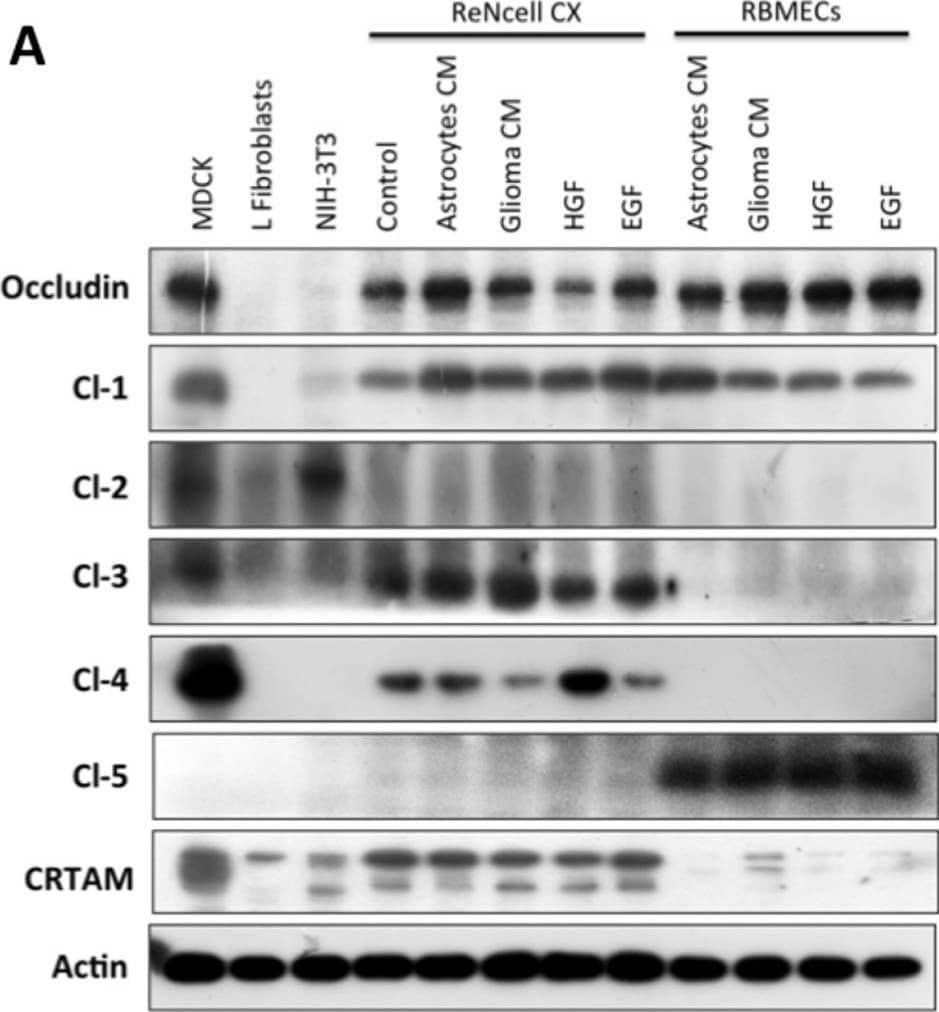Human CRTAM Antibody Summary
Ser18-Ser286
Accession # O95727
Applications
Please Note: Optimal dilutions should be determined by each laboratory for each application. General Protocols are available in the Technical Information section on our website.
Scientific Data
 View Larger
View Larger
Detection of CRTAM by Western Blot Expression of TJ proteins in transmigrating cells favors their passage across RBMECs.A) Analysis by Western blots of the expression of occludin, claudins 1 to 5 and CRTAM in NIH-3T3and L-fibroblasts, ReNcells CX and RBMECs. B) The transmigration of NIH-3T3 and L-fibroblasts acrossRBMECs is independent of the CM present in the basal compartment, but is significantly higher inNIH-3T3 fibroblasts that express claudin-2 than in L-fibroblast that do not express TJ proteins.N = 3, F(1,6) = 232.22, ***P<0.001; F(2,8) = 0.0895, ns = not significant; as assessed by two-wayANOVA followed by Bonferroni's post hoc test. C) Exogenous expression of occludin in L-fibroblastsenhances their transmigration across RBMECs monolayers. N = 9, t = 6.411, df = 8; ***P<0.001 asassessed by Student's t-test. D) Competing CRTAM mediated adhesion with soluble human CRTAM(CRTAM-Fc) added to the upper compartment of a Millicell insert, reduces transmigration of ReNcellsCX. N = 4, F(2,6) = 73.86; ***P<0.001, ns = not significant; as assessed by one-way ANOVAfollowed by Bonferroni's post hoc test. Image collected and cropped by CiteAb from the following open publication (https://pubmed.ncbi.nlm.nih.gov/23637756), licensed under a CC-BY license. Not internally tested by R&D Systems.
Preparation and Storage
- 12 months from date of receipt, -20 to -70 °C as supplied.
- 1 month, 2 to 8 °C under sterile conditions after reconstitution.
- 6 months, -20 to -70 °C under sterile conditions after reconstitution.
Background: CRTAM
CRTAM (Class I-restricted T cell-associated molecule) is a nectin family member of the immunoglobulin superfamily that is expressed by activated CD8+ and NK T cells (1‑4). NK activation receptor engagement, but not cytokines, also induce NK CRTAM expression (4, 5). CRTAM is found in spleen, thymus, small intestine, peripheral blood, and surprisingly, in brain where it is highly expressed by Purkinje cells of the cerebellum (1, 2). Human CRTAM is a 393 amino acid (aa), 80 kDa type I transmembrane glycoprotein with a 17 aa signal sequence, a 269 aa extracellular domain (ECD), a 21 aa transmembrane segment, and an 84 aa cytoplasmic domain. The ECD has one V-type and one C1-type Ig-like domain, while the cytoplasmic region shows a potential class I PDZ domain (1‑5). Human CRTAM ECD shows 70%, 43%, and 63% aa identity with mouse, rat, and canine CRTAM ECD, respectively, but 73‑78% aa identity within the Ig-like domains. The V-type Ig-like domain mediates interaction with the corresponding domain on another nectin family member, IGSF4 (also called TSLC-1, Necl-2, Syncam or SgIGSF) (4, 5). CRTAM is a homodimer on the cell surface but does not show homotypic binding in trans (3‑5). The high affinity of CRTAM/IGSF4 adhesion allows CRTAM to disrupt IGSF4 homotypic interactions (3‑5). IGSF4 and T cell receptor co-engagement of CRTAM-expressing CD8+ cells induces increased IFN-gamma or IL-22 production (3, 4). A role in cancer surveillance through NK cell-mediated rejection of IGSF4-expressing tumors has been proposed (3‑5). IGSF4 is expressed broadly, including on epithelia, neurons, a subset of tonsillar B cells (4, 5), and a rare splenic T zone-restricted BCDA3+ dendritic cell population which interacts with CRTAM (3).
- Kennedy, J. et al. (2000) J. Leukoc. Biol. 67:725.
- Patino-Lopez, G. et al. (2006) J. Neuroimmunol. 171:145.
- Galibert, L. et al. (2005) J. Biol. Chem. 280:21955.
- Boles, K. S. et al. (2005) Blood 106:779.
- Arase, N. et al. (2005) Int. Immunol. 17:1227.
Product Datasheets
Citation for Human CRTAM Antibody
R&D Systems personnel manually curate a database that contains references using R&D Systems products. The data collected includes not only links to publications in PubMed, but also provides information about sample types, species, and experimental conditions.
1 Citation: Showing 1 - 1
-
Transmigration of Neural Stem Cells across the Blood Brain Barrier Induced by Glioma Cells
Authors: Mónica Díaz-Coránguez, José Segovia, Adolfo López-Ornelas, Henry Puerta-Guardo, Juan Ludert, Bibiana Chávez et al.
PLoS ONE
FAQs
No product specific FAQs exist for this product, however you may
View all Antibody FAQsReviews for Human CRTAM Antibody
There are currently no reviews for this product. Be the first to review Human CRTAM Antibody and earn rewards!
Have you used Human CRTAM Antibody?
Submit a review and receive an Amazon gift card.
$25/€18/£15/$25CAN/¥75 Yuan/¥2500 Yen for a review with an image
$10/€7/£6/$10 CAD/¥70 Yuan/¥1110 Yen for a review without an image

